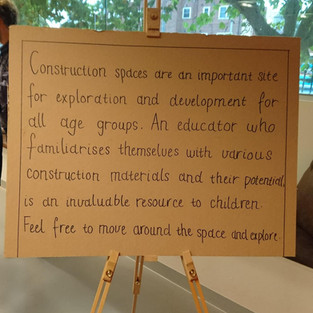Build, Create, Play: The Benefits of Playing with Building blocks
- Sophia Vidovic White
- Feb 22, 2019
- 4 min read
Updated: Feb 23, 2019
When it comes to design, construction spaces are an important site for exploration and development for all age groups. An educator who familiarises themselves with various construction materials and their potential, is an invaluable resource to children. Our classroom was fortunate enough to come across a number of recycled materials that were recycled into props for learning. We used recycled tubing, wood cut offs, wicker baskets and an abandoned wooden pallet that was restored to become a storage shelf. Building equipment has significant cognitive and academic benefits for children of all ages. These materials help children to develop a wide variety of skills and abilities. They help prepare our children for school and life! I guess you can say that these toys are the “building blocks” for success!

STEM Learning
To integrate STEM learning, problem solving, and critical thinking, we set up an architect desk. This included some construction pencils, blueprint paper, parts of a building poster, and models of various kinds of building to support our little architects. We also added blueprints to spark their imagination and get those ideas flowing! Mathematic thinking was evoked with the a supply of measuring tapes and measuring sticks so students can measure their structures during play. Our students were counting, comparing, measuring, and using tons of math vocabulary as they measured. Introductory math concepts are introduced such as counting, adding, subtracting and basic geometry as children play with building materials. Not only can children build shapes and numbers with the toys, but they can also count out the pieces and use mathematical calculations to build the perfect design. Through building, children learn to experiment and make new discoveries about how things work. They are also introduced to worlds of architecture and design which brings them into the STEM world.
The science of construction play
Block play offers an open-ended, creative and valuable play and learning experience available to every setting. It offers children freedom – to explore, take apart and put back together any block-based creation they can think of. When observing block play skilled practitioners can support children by identifying and supporting the Characteristics of Effective Learning. Key questions for educators to ask include:
+ Are the children having and following their own ideas? Are they choosing and exploring their own ways of doing things?
+ Are the children willing to have a go and take risks in their block play? Do they keep trying if things don’t work?
+ Are the children involved? Are they concentrating on what they want to achieve?
+ Are the children enjoying their play and discoveries? Do they enjoy achieving what they set out to do? By scaffolding ideas using open-ended questions or making ‘I wonder’ and ‘I notice’ comments to children, block play becomes an exciting environment in which practitioners can develop a deeper understanding of a child’s world.
Construction play helps children develop engineering skills
Toy blocks are an excellent educational investment.
It's easy to see how construction play could teach valuable lessons about architecture and engineering. Builders who create small-scale structures must cope with the same laws of physics that constrain the design of bridges and cathedrals. That's why engineers and scientists build physical models: It helps them test and explore their ideas. Studies also suggest that students learn best about physical forces when they experience them first-hand. If we want children to develop an intuitive grasp of mechanical forces -- like the forces of tension and compression -- construction play offers excellent learning opportunities.
Blocks stimulate creative, divergent problem-solving
Psychologists recognise two major types of problem. Convergent problems have only one correct solution. Divergent problems can be solved in multiple ways. Because children can put together blocks in a variety of ways, block play is divergent play. And divergent play with blocks may prepare children to think creatively and better solve divergent problems. Children who play with blocks perform better on divergent problems and they are able to show more creativity in their attempts to solve the problems.
Block play promotes better spatial reasoning
We know there are links between spatial skills and construction play. Children who showed more interest in construction -- and built more sophisticated structures -- performed better on a standardised test of spatial intelligence. There is good reason to think that construction play has developmental effects. When researchers assigned kindergartners' to participate in a program of guided construction play, these children subsequently outperformed their peers on tests of spatial visualisation, block building, and "mental rotation" -- the ability to rotate and analyse 3-D shapes in the "mind's eye" (Casey).
It Encourages Thinking and Reasoning
Every time a child builds and creates a structure or even an entire world, children have to use reasoning and critical thinking skills. They also have to problem solve when something does not work the way they hoped it would. These skills are what make children become well-rounded, independent and successful adults. In addition, it encourages children to use their minds instead of relying on technology so it's always beneficial to play with toys that focus on hands-on, interactive fun that requires thinking skills.









































Comments